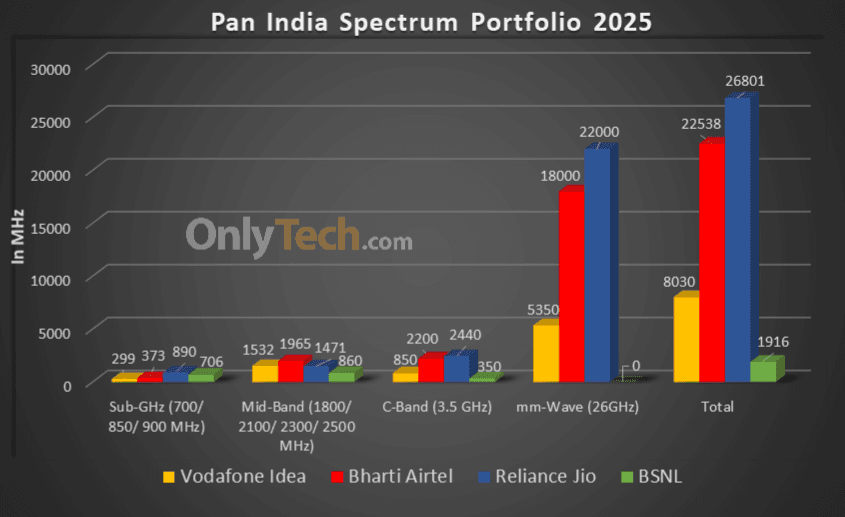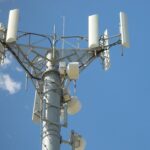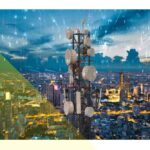Spectrum is for telecommunication what jet fuel is for aviation. Spectrum is a range of electromagnetic frequencies or airwaves that telecom companies use for establishing a connection between a cell tower and a mobile phone. The bandwidth of this spectrum is directly proportional to the speed of a wireless data network (since more data can be transmitted simultaneously through a broader data pipeline). In contrast, the frequency is inversely proportional to the coverage (since lower frequencies penetrate better through physical barriers and thus have wider coverage).
The spectrum holding data sheet embedded in this article represents the current spectrum holdings of all active telecom operators across all frequency bands across all 22 telecom circles along with their liberalisation status and expiry dates. All figures represented are in MHz. The value mentioned in the bracket beside the frequency at the base of each sheet is the band number where ‘B’ stands for 4G LTE band whereas ‘n’ stands for the corresponding 5G NR band.
The spectrum shown under BSNL and Aircel in white is reserved for the respective operators but has not yet been officially allotted to them.
Spectrum Liberalisation:
Spectrum was administratively allocated to operators in each of the 22 licensed service areas or circles prior to 2010, this spectrum is called non-liberalised and can only be used for 2G services whereas all airwaves allotted post-2010 have been through a Spectrum Auction where operators have paid the market discovered price and this spectrum is called liberalised and can be used for any technology platform 2G/3G/4G/5G. Alternatively, operators may choose to liberalise their administratively allotted spectrum by paying the market-discovered price to DoT on a pro-rata basis for the remaining validity of the spectrum.
Paired and Unpaired spectrum:
Spectrum may be paired or unpaired, bands 1/3/5/8/28 are all paired where one set of frequencies is used for uplink whereas another distinct set of frequencies is used for downlink known as Frequency-division duplexing (FDD), whereas bands 40/41/78/258 are unpaired where both uplink and downlink happens in the same set of frequencies separated by the time of uplink and downlink known as Time-division duplexing (TDD).
List of Indian FDD Bands:
| 4G LTE band | 5G NR band | Uplink frequency range (MHz) | Downlink frequency range (MHz) | Bandwidth for telecom (MHz) | Block size (MHz) |
|---|---|---|---|---|---|
| B1 | n1 | 1939-1979 | 2129-2169 | 40×2 | 5×2 |
| B3 | n3 | 1710-1780 | 1805-1875 | 70×2 | 0.2×2 |
| B5 | n5 | 824-844 | 869-889 | 20×2 | 1.25×2 |
| B8 | n8 | 890-915 | 935-960 | 25×2 | 0.2×2 |
| B28 | n28 | 723-733/ 738-748 | 778-788/ 793-803 | 20×2 | 5×2 |
List of Indian TDD Bands:
| 4G LTE band | 5G NR band | Frequency range (MHz) | Bandwidth for telecom (MHz) | Block size (MHz) |
|---|---|---|---|---|
| B40 | n40 | 2300-2380 | 80 | 10 |
| B41 | n41 | 2535-2555/ 2615-2655 | 60 | 10 |
| – | n78 | 3300-3670 | 370 | 10 |
| – | n258 | 24250-27500 | 3250 | 50 |
Spectrum caps:
A spectrum cap dictates how much spectrum a particular operator can hold in a circle for a specific band. There is a 40% cap for Sub-GHz spectrum in the 700/850/900 MHz bands combined, a 40% cap for Mid-Band spectrum in the 1800/2100/2300/2500 MHz bands combined, a 40% cap for the C-Band spectrum of 3300-3670 MHz and a 40% cap for the mm-Wave spectrum bands of 24.25-27.5 GHz. The current spectrum caps are denoted in the spectrum chart.
Overall spectrum holdings of operators (in MHz):
| Operator/Holding | Jio | Airtel | Vi | BSNL |
|---|---|---|---|---|
| Sub-GHz | 890 | 373.2 | 298.8 | 706 |
| Mid Band | 1470.8 | 1964.9 | 1531.6 | 860 |
| C-Band | 2440 | 2200 | 850 | 350 |
| mm-Wave Band | 22000 | 18000 | 5350 | 0 |
| Total | 26,800.8 | 22,538.1 | 8,030.4 | 1,916 |
Spectrum sharing/trading/leasing guidelines:
- Telecom operators holding CMTS/UASL/UL licenses can enter into a Spectrum-Sharing agreement with each other so long as both parties hold liberalised spectrum in the same band in the same circle. Spectrum sharing is possible only on a Pan LSA level in block sizes defined by DoT and only after one year of an operator acquiring the spectrum.
- Telecom operators holding CMTS/UASL/UL licenses can enter into a Spectrum-Trading agreement with each other so long as the spectrum being sold is liberalised. Trading of spectrum is possible only on a Pan LSA level in block sizes defined by DoT and only after two years of an operator acquiring the spectrum.
- Telecom operators may enter into a Spectrum-Leasing agreement only with Enterprises holding a Captive Non-Public Network (CNPN) license and not with each other. The lease may be limited to any geographic area within the LSA and for any duration mutually agreed upon by both parties. A CNPN licensee can lease spectrum from multiple operators within an LSA.
Note: We update this chart in real-time to ensure it is always up to date with the latest changes in spectrum holding. Certain human errors might have crept in during the manual compilation of the data, any mistakes/ rectification can be brought to the Team’s notice through the comments section below.








@Esmail,
– If there are 4 sectors in a BTS/site (e.g. of Airtel), can the transmission power be increased individually for each sector separately or is it done site/BTS level for all? Also, if 2 companies (Airtel & Vi) are sharing the same tower (with different BTS) does increasing or decreasing the transmission power apply to each of them differently or its the same for all those who are sharing the tower?
Hey Anand, that will depend on how the Self Optimising Network (SON) is configured. If the change in transmission power is linked to the load of users connected to each transceiver then it can be different for each sector, if it is linked to the time of the day like late nights where operators prefer energy saving mode then all sectors transmission power can be reduced simultaneously.
And as far as the different operators are concerned, they only share the tower mast and passive infrastructure and have their own transceivers mounted on them. So the change in transmission power of one operator will not directly affect the other.
Esmail Sir, 900 band has 25mhz spectrum. But if look at and add up spectrum holdings of all telcos including unsold ones, it doesnt add up to 25mhz. What happend to the rest of the spectrum?
Secondly, since there are still and will be millions of 2G users who are not interested in or comfortable with or dont need smartphones or internet/4G/5G, is it possible to have one common set of 2G 900 band spectrum (say jut 2-3 mhz) & infrastructure (handled by one telco), which can be commonly accessed and used by all telcos – bsnl, airtel, vi – and all of them sharing costs?
Of the remaining spectrum, some is held by ministry of defence, 1.8 MHz in many circles is still with Indian railways and they are also slowly vacating it. Very little is locked up in guard band and can be released through harmonisation. In the next few years we will see the entire 25 MHz being freed up for commercial telecom.
As for 2G it is completely the operator’s choice as to whether or not they want to continue with the network. Operators like Airtel, Vi and BSNL will continue to support 2G for many more years until most of the user base has shifted to 4G and 5G and then just like 3G was shut they can close 2G even.
About the spectrum sharing, again it is up to the telcos as to whether they want to pool their 900 and 1800 MHz holdings with each other and use it for 2G, but it has to have shared spectrum from all the operators, it can’t be one operator owning it and the others leasing it from them.
telco already using Dynamic spectrum sharing
thus it doesn’t make much difference in term of load,
and dedicated 2-3 depending on number of user per area/per telco.
i wish vi should sell 2g network and subscribers to bsnl/vno backed by bsnl in lieu of govt holding 33%.
thus vi can purely focus on 4g subsriber and invest in 5g SA network over period of 4years.
Few months back its vi who was shout loud for unvibility of 2g network after announcing of IUC to make zero